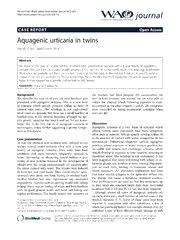
Aquagenic urticaria in twins. PDF
Preview Aquagenic urticaria in twins.
KaiandFlohrWorldAllergyOrganizationJournal2013,6:2 journal http://www.waojournal.org/content/6/1/2 CASE REPORT Open Access Aquagenic urticaria in twins Anneke C Kai1* and Carsten Flohr1,2 Abstract We describe the case of18 year old twin brothers who presented to our unit witha 3 year history of aquagenic urticaria. This rare form of urticaria usually presents within anhour of contact withwater. The aetiologyis unknown. Most cases are sporadic but thereare a small number offamilial cases inthe medical literature.A specific genetic mutation has not yet been found. To our knowledge, this is the firstreport ofaquagenic urticariain monozygotic twins, further supporting a genetic component to this disease. Keywords: Urticaria, Aquagenic Background the brothers had been adopted. On examination, the We describe the case of 18 year old twin brothers who skin of both brothers was normal but we were able to presented with aquagenic urticaria. This is a rare form induce the classical wheals following exposure to water of urticaria which usually presents within an hour of inashowerinourclinic(Figures1and2).Thesymptoms contact with water. The aetiology is not understood. were controlled by taking prophylactic cetirizine 10mg Most cases are sporadic but there are a small number of onceperday. familial cases in the medical literature although no spe- cific genetic mutation has been found yet.To our know- ledge, this is the first report of aquagenic urticaria in Discussion monozygotic twins, further supporting a genetic compo- Aquagenic urticaria is a rare form of urticaria which nent tothis disease. affects women more commonly than men. Symptoms often start in puberty. Wheals usually develop within 30 to 60 minutes of contact with water, irrespective of the Case presentation temperature. Differential diagnoses include aquagenic 18 year old identical twin brothers were referred to our pruritus, where exposure to water induces pruritus but tertiary referral centre urticaria clinic with a three year no visible skin lesions, and cholinergic urticaria, where history of aquagenic urticaria. They were both keen wheals develop inresponse to heat,exertion,sweatingor triathletes and were therefore frequently exposed to emotional stress. The aetiology is not understood. It has water. Swimming or showering would induce a pro- been suggested that water interacting with sebum or se- drome of skin pruritus followed by the development of baceous glands can produce a toxin causing degranula- wheals over the trunk approximately 15 minutes after tion of mast cells, leading to histamine release and the initial contact with water. The wheals were induced wheal formation. An alternative explanation has been by both hot and cold water. They would resolve spon- that water-soluble antigens in the epidermis diffuse into taneouslyafter about one hour,leavingnoresidual mark. the dermis and cause a histamine mediated reaction. Neither brother had ever experienced any associated Oral antihistamines are used as first line treatment, up angioedema.Exercisesuchasrunningwouldonlyinduce to four times the standard single daily dose. Successful itching. There was no history of atopy and both brothers treatmentwith UVB andPUVAhasalso been reported. were in good general heath and were not taking any Although almost all cases of aquagenic urticaria are regular medications. The family history was unknown as sporadic, therearea smallnumberoffamilialcasesinthe *Correspondence:[email protected] medical literature [1-7]. Some of these cases have been 1CutaneousAllergyDepartment,StJohn’sInstituteofDermatology,Guy’s& reported in association with other conditions, a few of StThomas’NHSFoundationTrust,WestminsterBridgeRoad,LondonSE1 whicharegeneticallylinked.Forexample,Pitarchetal.[1] 7EH,UK Fulllistofauthorinformationisavailableattheendofthearticle published a case of three affected female siblings all with ©2013KaiandFlohr;licenseeBioMedCentralLtd.ThisisanOpenAccessarticledistributedunderthetermsoftheCreative CommonsAttributionLicense(http://creativecommons.org/licenses/by/2.0),whichpermitsunrestricteduse,distribution,and reproductioninanymedium,providedtheoriginalworkisproperlycited. KaiandFlohrWorldAllergyOrganizationJournal2013,6:2 Page2of2 http://www.waojournal.org/content/6/1/2 supporting the notion that there is a genetic component to this type of urticaria, as suggested by others. It is hoped that new generation sequencing/exome sequen- cing will be able to shed further light on the genetic traitsinvolved. Consent Writteninformedconsentwasobtainedfromthepatients forpublicationofthisCaseReportandanyaccompanying images. A copy of the written consent is available for reviewbytheEditor-inChiefofthisjournal. Competinginterests Theauthorsdeclarethattheyhavenocompetinginterests. Figure1Whealsontorsoafterwaterexposure. Authors’contributions CFprovidedthecasehistory.AKcarriedouttheliteraturereviewandwrote thediscussion.Allauthorsreadandapprovedthefinalmanuscript. co-existent. Bernard-Soulier Syndrome, a rare autosomal recessive disorder causing a prolonged bleeding time for Authordetails which more than 30 mutations of the GPIbα, GPIbβ and 1CutaneousAllergyDepartment,StJohn’sInstituteofDermatology,Guy’s& StThomas’NHSFoundationTrust,WestminsterBridgeRoad,LondonSE1 GPIX genes have been described [8]. These genes map to 7EH,UK.2King’sCollegeLondon,Strand,LondonWC2R2LS,UK. chromosomes17p12,22q11.2and3q21respectively.They postulatedthatalthoughtheassociationcouldbeacoinci- Received:9September2012Accepted:16January2013 Published:31January2013 dence,itmightconstituteanassociationofgeneticloci. Treudler er al [2] reported an association of familial References aquagenic urticaria with familial lactose intolerance 1. PitarchG,TorrijosA,Martínez-MenchónT,Sánchez-CarazoJL,ForteaJM: Familialaquagenicurticariaandbernard-souliersyndrome.Dermatology over three generations. They described a male patient 2006,212(1):96–7. with aquagenic urticaria whose grandmother, mother, 2. TreudlerR,TebbeB,SteinhoffM,OrfanosCE:Familialaquagenicurticaria aunt and cousin were all affected. The patient, associatedwithfamiliallactoseintolerance.JAmAcadDermatol2002, 47(4):611–3. mother and grandmother were also affected by fami- 3. SeizeMB,IanhezM,deSouzaPK,RottaO,CestariSdaC:Familialaquagenic lial lactose intolerance. Familial lactose intolerance is urticaria:reportoftwocasesandliteraturereview.AnBrasDermatol caused by a deficiency of the enzyme lactase which is 2009,84(5):530–3. 4. BonnetblancJM,Andrieu-PfahlF,MeraudJP,RouxJ:Familialaquagenic encoded on chromosome 2, a different genetic locus urticaria.Dermatologica1979,158(6):468–70. to the mutations causing Bernard-Soulier syndrome 5. CzarnetzkiBM,BreetholtKH,TraupeH:Evidencethatwateractsasa (chromosomes 17, 22 and 3). carrierforanepidermalantigeninaquagenicurticaria.JAmAcad Dermatol1986,15(4Pt1):623–7. 6. TromovitchTA:Urticariafromcontactwithwater.CalifMed1967,106(5):400–1. 7. ShelleyWB,RawnsleyHM:Aquagenicurticaria.Contactsensitivity Conclusions reactiontowater.JAMA1964,189:895–8. To thebest ofourknowledge, this isthefirstcasereport 8. KunishimaS,KamiyaT,SaitoH:GeneticabnormalitiesofBernard-Soulier of aquagenic urticaria in monozygotic twins, further syndrome.IntJHematol2002,76(4):319–27. doi:10.1186/1939-4551-6-2 Citethisarticleas:KaiandFlohr:Aquagenicurticariaintwins.World AllergyOrganizationJournal20136:2. Submit your next manuscript to BioMed Central and take full advantage of: • Convenient online submission • Thorough peer review • No space constraints or color figure charges • Immediate publication on acceptance • Inclusion in PubMed, CAS, Scopus and Google Scholar • Research which is freely available for redistribution Figure2Close-upviewofwhealontorsoafterwaterexposure. Submit your manuscript at www.biomedcentral.com/submit
